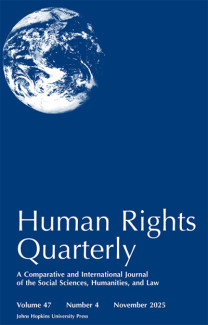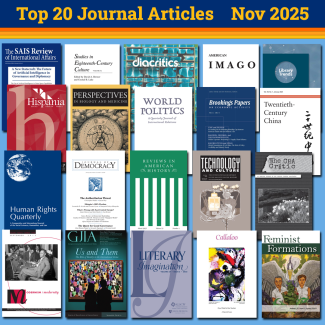
Johns Hopkins UniversityEst. 1876
America’s First Research University
To form “a more-perfect-though-never-actually-perfect union”: An interview with historian Jane Kamensky

The September 2019 issue of Reviews in American History introduced readers to a new and unique feature. Although RAH is a book review journal, “Process Stories” presents essays that do not review a specific title, but instead look more personally and concretely at how historiography shapes the way scholars teach, theorize, write, and/or serve. The first “Process Story” is Jane Kamensky’s Two Cheers for the Nation: An American Revolution for the Revolting United States. We took some time with Harvard Professor Kamensky to find out more about her work as a historian, and her essay - a thoughtful reflection on her challenges as an educator to teach our nation’s complex history critically while keeping students energized and civically engaged.
How did your essay become the first Process Story?
I've been really impressed with what Ari Kelman and his board are doing with RAH, so I reached out to him with a draft of "Two Cheers," which started as a talk for a workshop in Melbourne in late 2018. The talk was an odd genre: part historiography, part pedagogy, part personal essay, and part op-ed -- not a conventional academic journal article. It turned out that Ari had been noodling around with ideas for new formats for RAH to test-pilot, so we decided to experiment together.
In your piece, you relay how you carefully shaped the curricula for your first undergraduate class on the American Revolution, being mindful to include texts that reveal events and viewpoints not “traditionally” taught about that time period. How did your experience learning about “The Spirit of ‘76” in primary and secondary school shape your decisions as an educator?
My path into American history was winding and stony. In my school daze, I learned US history largely by rote memorization. One of my teachers was literally criminal, I discovered after the fact. Our high school textbook was the Thomas Bailey "OG" edition of The American Pageant. We were asked to recite, from Bailey, the height and weight of every US president. The bicentennial, which hit when I was 13, seemed like a bad joke. I remember my mother breaking in at the family dinner table with fake "bicentennial minutes." The one thing I knew I didn't want to be when I started college was an American historian.
Was there a particular book, course, or instructor in your schooling that inspired you to become a historian?
I majored in history at Yale in the early 1980s because everybody majored in history at Yale in the early 1980s. (That's still true, though I'm not sure how they do it!) I think I followed a cute boy to a class on European diplomacy between the Congress of Vienna and the WWI Armistice. I took virtually no US history as an undergraduate, and in fact petitioned the Director to let me waive the US history requirement based on two weeks of syllabus in a European history course. I can still hear that distinguished historian of the former Yugoslavia saying, with a heavy Eastern European accent, I'll allow it, but between you and me, this is boolsheet. After graduation, I wound up, upon quitting a lucrative finance job, working in the typing pool at Columbia's development office. I got free tuition and took a US women's history course, with Rosalind Rosenberg, maybe because of the time it met. It knocked me off my pins. I wrote my grad school essays saying that Linda Gordon's Woman's Body, Woman's Right had convinced me to study 20th-century social and political history. Then I got to grad school, met John Demos, and read Edmund Morgan's American Slavery, American Freedom. I was "early" to the core from that moment on.
You write how one of your students, a Revolutionary War event re-enactor, decided to quit his longstanding involvement in the club after your class. He felt despondent after learning some ugly truths about the war and exclaimed, “Who could be proud of that?” As you describe it, “Shame and veneration are but opposite sides of the same coin.” Shifting a bit forward, historically: how do you feel the removal of civil war memorials in cities across the country helps or harms the ability of our citizens to understand the past, and/or motivate them towards positive change?
The fate of Confederate monuments, most of them erected by white supremacists in the Redemption that rolled back Reconstruction, is a complicated issue about which many people are justifiably passionate. As a general rule, I favor addition to subtraction: teach it, contextualize it, talk back to it, make it listen. Place Stonewall Jackson on horseback beside Kehinde Wiley's magnificent Rumors of War. Wrap it in shiny polymer, as Karyn Olivier did with an outdated Philadelphia monument, so that it reflects us back to ourselves. Make viewers see it fresh and whole. Interpret, loudly, with bells on. That's the work historians do best.
Do you feel the current political climate of incivility exacerbates the lack of civic engagement by our younger citizens? Do we have rose colored glasses on about a proverbial former time of civility?
I worry less about incivility than I do about incapacity. Joanne Freeman's books demonstrate conclusively that the work of governing the United States has never been genteel, and has rarely qualified as civil. The nation was of course born in civil war, as well as in a lather of brilliance and purpose. It's ok to fight, as long as we fight earnestly and fair. If our younger citizens don't know how to debate robustly and with civic purpose, it's because we--the higher ed we here, though there are many others--have lost our ardor for teaching them those skills. We don't need to look back to a halcyon time of civility. We need to look forward to a moment of high civic engagement, to model and to instruct in the fundamentals of effective civic engagement, including that elusive marriage of principle, coalition, and compromise that the country's founders managed more often than we seem to.
You describe the lyrics of Hamilton as “egregiously hagiographic”. It was recently announced that Disney will be widely releasing a film version of the musical next year. Do you think the play has done more harm than good, or are you grateful for it at least causing an uptick in interest in U.S. history, despite its shortcomings?
Australia is literally on fire, so it would seem churlish to waste eyeballs taking potshots at Hamilton. Do I love it? No, but that's ok, because it loves itself enough for the both of us. Hamilton is good for business, and it's not bad for America. But really, I want Stephen Sondheim to make Copley!
You mention in your essay plans to teach the course again in the Fall. As we’re now well into the spring semester, can you tell us: how did the second round of the class go? Did you come away with any further insights about inspiring community engagement?
Well, I did what I promised RAH readers, swapping out some of my previous readings, and structuring an engaged learning capstone. Students worked in teams with community partners on various public-facing projects. Teaching in greater Boston, self-proclaimed "cradle of liberty," made for some amazing opportunities. Students devised a toolkit for the museum educators working on the extraordinary exhibit of Jacob Lawrence's Revolutionary War and early Republic series, The American Struggle, at Peabody Essex Museum. They transcribed and exhibited obscure George Washington letters at the NPS Longfellow House, which served as headquarters in the early days of the Revolution. Several teams worked with the American Repertory Theater on its upcoming production of 1776, which I can't wait to see when it opens later this spring. The students faced hard histories and found pride and a common inheritance, across all their diversity, in the American experience. We really did read the Declaration out loud, as a group. And I promise, I wasn't the only one crying by the end.
As you note in your piece, some days it’s an act of bravery to read the news. Have there been moments, individuals, or research in recent memory that give you hope for reinvestment in our democratic citizenship?
Yes! I've been working since last summer as part of the team shepherding Educating for American Democracy, a massive project funded by the NEH and the Department of Education. This four-institution (iCivics, Tufts, Arizona State University, and Harvard), three-task force, roughly hundred-person effort aims to provide a roadmap to help teachers integrate American history and civics content, as well as instruction in historical thinking and civic reasoning skills, for all learners in K-12 environments across the United States. Our steering committee and task forces--I co-chair the American history task force with the brilliant and indefatigable Tammy Waller, Director of K-12 Social Studies and World Languages for the state of Arizona--span a broad range of educators, from primary school teachers to scholars at research institutions to curriculum providers like Facing History and Ourselves and the Bill of Rights Institute. There is a wide ideological span among the project members. We speak hard truths, and we listen to each other. It's thrilling, a tonic.
Tell us what’s next for you. Are you currently working on another book?
I'm studying a different revolution right now, working on a book about the American sexual revolution as seen from below, as it were, through the biography of pornographic actress and erotica entrepreneur Candida Royalle (1950-2015). Like the American Revolution, the sexual revolution was a civil war. As to who won and who lost, and whether there are any founding documents to be proud of: the verdict seems to me still very mixed.
Jane Kamensky is Jonathan Trumbull Professor of American History at Harvard University and the Pforzheimer Foundation Director of the Arthur and Elizabeth Schlesinger Library on the History of Women in America at the Radcliffe Institute for Advanced Study. Her most recent book, A Revolution in Color: The World of John Singleton Copley (2016), won four prizes, including the New-York Historical Society’s Barbara and David Zalaznick Book Prize. With Edward G. Gray, she is coeditor of the Oxford Handbook of the American Revolution (2013). A former Commissioner of the National Portrait Gallery, she serves as a Trustee of the Museum of the American Revolution. She is currently working on a history of the sexual revolution as revealed by the biography of feminist sex radical Candida Royalle. Candida Royalle and the Sexual Revolution: A History from Below, will be published by W.W. Norton.


